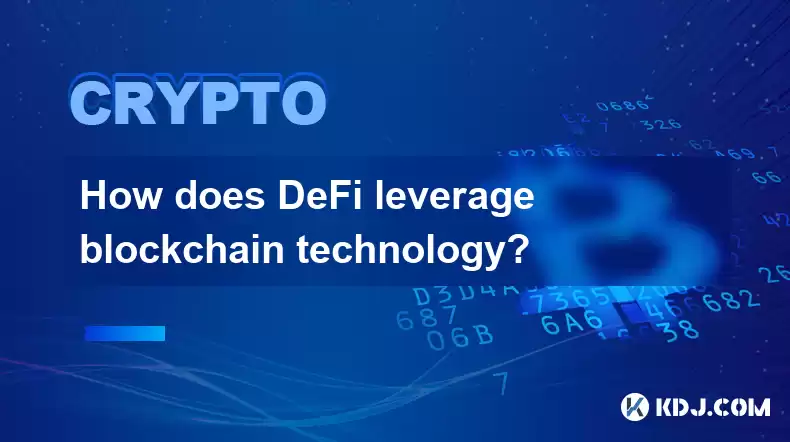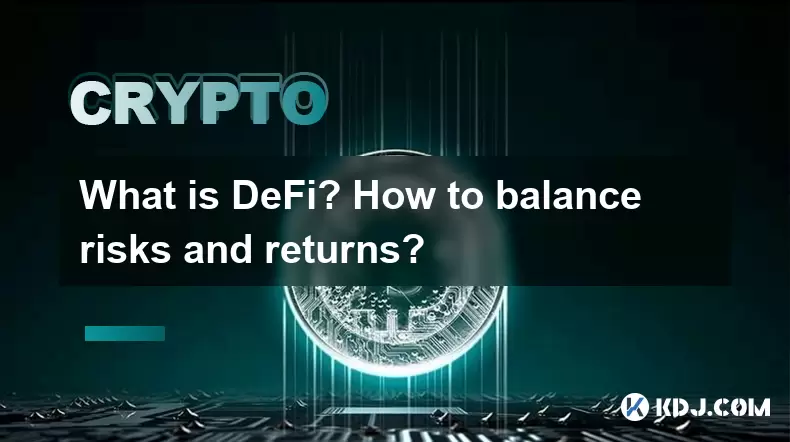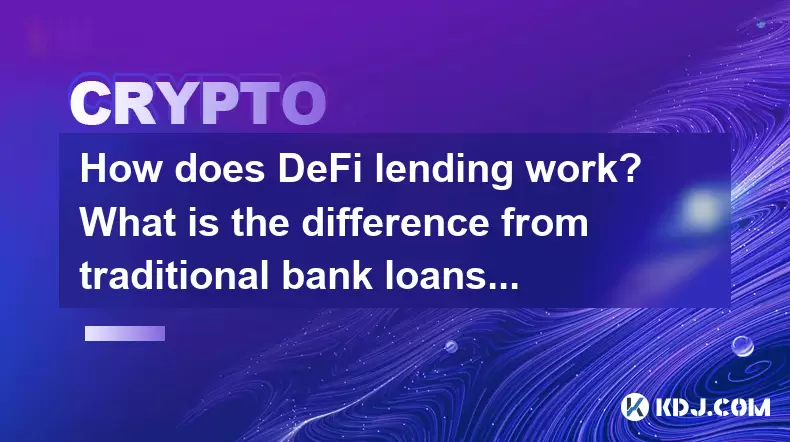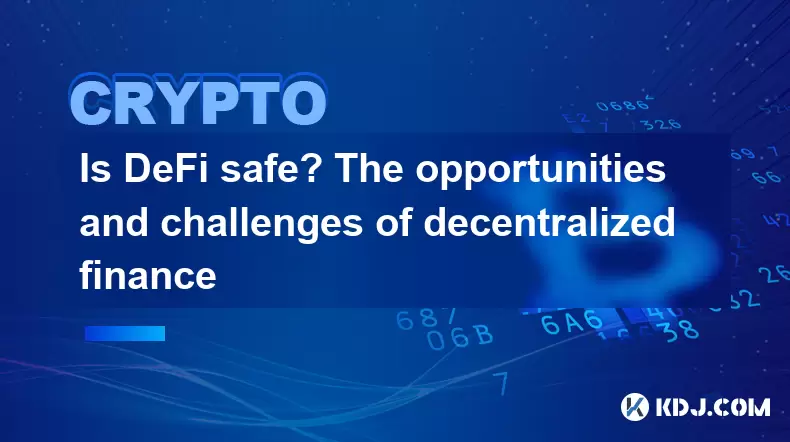-
 bitcoin
bitcoin $118548.520763 USD
3.67% -
 ethereum
ethereum $4352.564943 USD
4.79% -
 xrp
xrp $2.964058 USD
4.22% -
 tether
tether $1.000565 USD
0.05% -
 bnb
bnb $1028.372955 USD
1.46% -
 solana
solana $221.373507 USD
6.00% -
 usd-coin
usd-coin $0.999933 USD
0.02% -
 dogecoin
dogecoin $0.248633 USD
6.85% -
 tron
tron $0.341444 USD
2.38% -
 cardano
cardano $0.852946 USD
5.82% -
 hyperliquid
hyperliquid $47.869306 USD
6.15% -
 chainlink
chainlink $22.561476 USD
6.01% -
 ethena-usde
ethena-usde $1.001258 USD
0.05% -
 avalanche
avalanche $30.660000 USD
2.06% -
 stellar
stellar $0.400917 USD
9.76%
How does DeFi leverage blockchain technology?
DeFi leverages blockchain's immutability and transparency, enabling secure, automated transactions via smart contracts on decentralized exchanges and lending platforms, creating a trustless financial ecosystem.
Mar 13, 2025 at 01:20 pm

- DeFi applications rely on smart contracts for automation and trustlessness.
- Blockchain's immutability and transparency ensure secure and verifiable transactions.
- Decentralized exchanges (DEXs) offer peer-to-peer trading without intermediaries.
- Lending and borrowing platforms utilize blockchain for collateralization and risk management.
- DeFi protocols leverage blockchain for creating and managing various financial instruments.
Decentralized finance (DeFi) is a rapidly growing sector that aims to recreate traditional financial services in a decentralized manner, utilizing the unique properties of blockchain technology. This revolutionary approach eliminates the need for intermediaries like banks and brokers, offering increased transparency, efficiency, and accessibility. The core of DeFi's functionality rests on its seamless integration with blockchain's inherent features.
Blockchain technology underpins DeFi's entire structure. Its distributed ledger system ensures transparency, allowing anyone to view transactions on the public network. This open and verifiable nature fosters trust among participants, mitigating the risks associated with centralized systems. The immutability of blockchain prevents alteration of past transactions, guaranteeing the integrity of the DeFi ecosystem.
Smart contracts are the engine driving DeFi applications. These self-executing contracts, coded onto the blockchain, automate processes like lending, borrowing, and trading, eliminating the need for intermediaries to enforce agreements. Smart contracts operate autonomously based on pre-defined rules, ensuring that transactions are executed accurately and transparently.
Decentralized exchanges (DEXs) are a prime example of DeFi's utilization of blockchain. Unlike centralized exchanges, DEXs facilitate peer-to-peer trading directly between users without relying on a central authority. This removes single points of failure and reduces the risk of censorship or manipulation. The trading process is automated through smart contracts, enhancing speed and efficiency.
Lending and borrowing platforms in the DeFi space heavily leverage blockchain's capabilities. These platforms allow users to lend or borrow cryptocurrencies, using blockchain for collateral management and risk assessment. Smart contracts automatically execute loan agreements, ensuring timely repayment and minimizing counterparty risk. The transparency of blockchain allows lenders to monitor the collateral and borrowers' creditworthiness.
Stablecoins, a crucial component of DeFi, are often pegged to fiat currencies like the US dollar and are frequently issued on blockchain networks. This stable value reduces volatility compared to other cryptocurrencies and enables smoother transactions within the DeFi ecosystem. Blockchain's transparency and auditability help maintain the stability and credibility of these assets.
DeFi protocols utilize blockchain for creating and managing a wide range of financial instruments. These include synthetic assets that mimic traditional assets like stocks or commodities, offering exposure to these markets without direct ownership. The ability to create and trade these instruments on the blockchain opens new opportunities for innovation and diversification within the DeFi space.
The security of DeFi protocols is paramount. While blockchain's inherent security features provide a strong foundation, vulnerabilities in smart contracts can still be exploited. Rigorous audits and security best practices are crucial to mitigating these risks. The open-source nature of many DeFi protocols enables community scrutiny, further strengthening security.
The scalability of blockchain networks is also a crucial factor in DeFi's development. High transaction fees and slow processing speeds can hinder the adoption and growth of DeFi applications. Ongoing research and development are focused on improving scalability to ensure the efficiency and accessibility of the DeFi ecosystem.
The regulatory landscape surrounding DeFi is still evolving. Governments worldwide are grappling with the implications of decentralized finance and are working to establish appropriate regulatory frameworks. The regulatory uncertainty poses challenges to the long-term growth and stability of the DeFi space.
Frequently Asked Questions:Q: What are the advantages of using blockchain in DeFi?A: Blockchain offers several advantages, including increased transparency, immutability, security, and automation through smart contracts. It eliminates the need for intermediaries, reducing costs and increasing efficiency.
Q: How does DeFi ensure security?A: DeFi relies on blockchain's inherent security features, but also employs smart contracts which, when well-designed and audited, can minimize vulnerabilities. However, smart contract vulnerabilities remain a concern and require ongoing vigilance.
Q: What are the risks associated with DeFi?A: Risks include smart contract vulnerabilities, the volatility of cryptocurrencies, regulatory uncertainty, and the potential for hacks and scams. Users should conduct thorough research and understand the risks involved before participating in DeFi.
Q: How does DeFi differ from traditional finance?A: DeFi is decentralized, transparent, and permissionless, unlike traditional finance which relies on centralized intermediaries. DeFi operates on blockchain, providing increased efficiency and accessibility.
Q: What is the future of DeFi?A: The future of DeFi is uncertain but holds immense potential. Ongoing developments in scalability, regulatory clarity, and the integration of new technologies could lead to widespread adoption and transform the financial landscape.
Disclaimer:info@kdj.com
The information provided is not trading advice. kdj.com does not assume any responsibility for any investments made based on the information provided in this article. Cryptocurrencies are highly volatile and it is highly recommended that you invest with caution after thorough research!
If you believe that the content used on this website infringes your copyright, please contact us immediately (info@kdj.com) and we will delete it promptly.
- BlockDAG, DOGE, HYPE Sponsorship: Crypto Trends Shaping 2025
- 2025-10-01 00:25:13
- Deutsche Börse and Circle: A StableCoin Adoption Powerhouse in Europe
- 2025-10-01 00:25:13
- BlockDAG's Presale Buzz: Is It the Crypto to Watch in October 2025?
- 2025-10-01 00:30:13
- Bitcoin, Crypto, and IQ: When Genius Meets Digital Gold?
- 2025-10-01 00:30:13
- Stablecoins, American Innovation, and Wallet Tokens: The Next Frontier
- 2025-10-01 00:35:12
- NBU, Coins, and Crypto in Ukraine: A New Yorker's Take
- 2025-10-01 00:45:14
Related knowledge

How to track DeFi activity on a block explorer
Sep 04,2025 at 05:36pm
Bitcoin's Role in Decentralized Finance1. Bitcoin remains the cornerstone of the cryptocurrency ecosystem, serving as both a store of value and a benc...

What is the difference between DeFi and CeFi? An article analyzing the advantages and disadvantages of both
Jun 13,2025 at 03:57am
Understanding the Foundations of DeFi and CeFiTo fully grasp the difference between DeFi (Decentralized Finance) and CeFi (Centralized Finance), it’s ...

What is DeFi? How to balance risks and returns?
May 31,2025 at 12:22pm
What is DeFi? How to Balance Risks and Returns? Decentralized Finance, commonly known as DeFi, represents a revolutionary shift in the financial ecosy...

How does DeFi lending work? What is the difference from traditional bank loans?
May 29,2025 at 05:36pm
Introduction to DeFi LendingDeFi lending, or decentralized finance lending, represents a revolutionary shift in the way borrowing and lending are cond...

Is DeFi safe? The opportunities and challenges of decentralized finance
May 27,2025 at 02:28pm
Decentralized Finance, commonly known as DeFi, has revolutionized the financial landscape by offering a range of financial services without the need f...

DeFi Mining Tutorial: How to Maximize Profits and Reduce Risks?
May 27,2025 at 07:42am
DeFi, or Decentralized Finance, has opened up a new world of opportunities for crypto enthusiasts looking to maximize their profits through various mi...

How to track DeFi activity on a block explorer
Sep 04,2025 at 05:36pm
Bitcoin's Role in Decentralized Finance1. Bitcoin remains the cornerstone of the cryptocurrency ecosystem, serving as both a store of value and a benc...

What is the difference between DeFi and CeFi? An article analyzing the advantages and disadvantages of both
Jun 13,2025 at 03:57am
Understanding the Foundations of DeFi and CeFiTo fully grasp the difference between DeFi (Decentralized Finance) and CeFi (Centralized Finance), it’s ...

What is DeFi? How to balance risks and returns?
May 31,2025 at 12:22pm
What is DeFi? How to Balance Risks and Returns? Decentralized Finance, commonly known as DeFi, represents a revolutionary shift in the financial ecosy...

How does DeFi lending work? What is the difference from traditional bank loans?
May 29,2025 at 05:36pm
Introduction to DeFi LendingDeFi lending, or decentralized finance lending, represents a revolutionary shift in the way borrowing and lending are cond...

Is DeFi safe? The opportunities and challenges of decentralized finance
May 27,2025 at 02:28pm
Decentralized Finance, commonly known as DeFi, has revolutionized the financial landscape by offering a range of financial services without the need f...

DeFi Mining Tutorial: How to Maximize Profits and Reduce Risks?
May 27,2025 at 07:42am
DeFi, or Decentralized Finance, has opened up a new world of opportunities for crypto enthusiasts looking to maximize their profits through various mi...
See all articles










































































